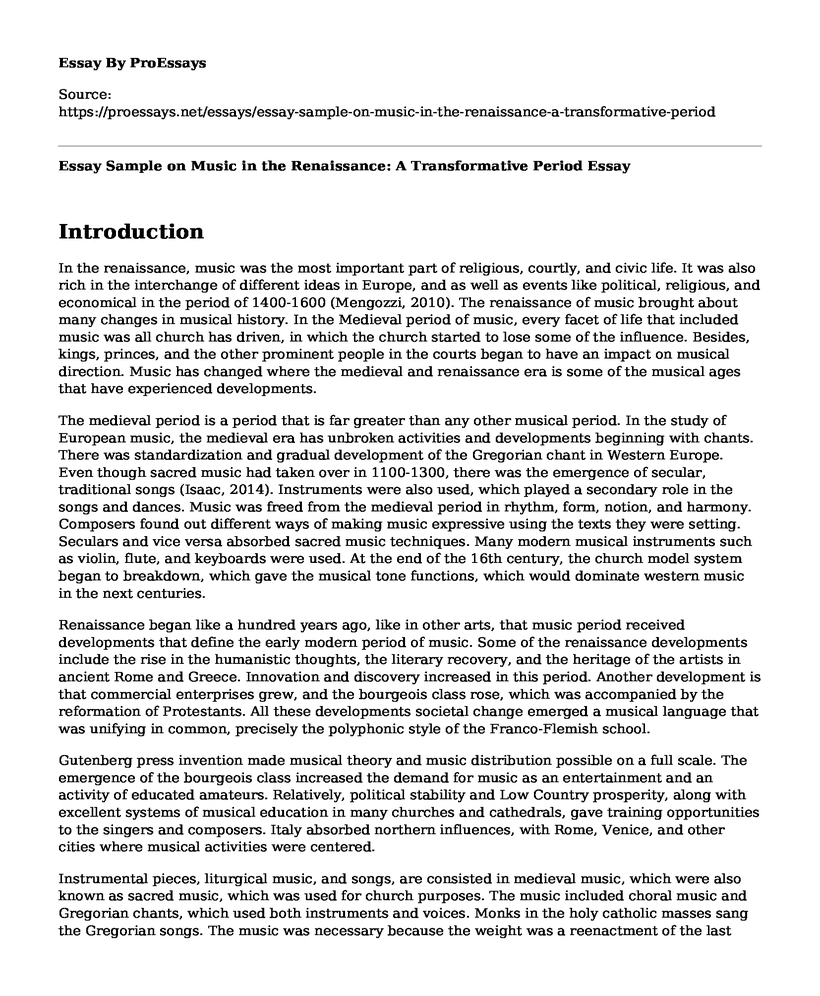Introduction
In the renaissance, music was the most important part of religious, courtly, and civic life. It was also rich in the interchange of different ideas in Europe, and as well as events like political, religious, and economical in the period of 1400-1600 (Mengozzi, 2010). The renaissance of music brought about many changes in musical history. In the Medieval period of music, every facet of life that included music was all church has driven, in which the church started to lose some of the influence. Besides, kings, princes, and the other prominent people in the courts began to have an impact on musical direction. Music has changed where the medieval and renaissance era is some of the musical ages that have experienced developments.
The medieval period is a period that is far greater than any other musical period. In the study of European music, the medieval era has unbroken activities and developments beginning with chants. There was standardization and gradual development of the Gregorian chant in Western Europe. Even though sacred music had taken over in 1100-1300, there was the emergence of secular, traditional songs (Isaac, 2014). Instruments were also used, which played a secondary role in the songs and dances. Music was freed from the medieval period in rhythm, form, notion, and harmony. Composers found out different ways of making music expressive using the texts they were setting. Seculars and vice versa absorbed sacred music techniques. Many modern musical instruments such as violin, flute, and keyboards were used. At the end of the 16th century, the church model system began to breakdown, which gave the musical tone functions, which would dominate western music in the next centuries.
Renaissance began like a hundred years ago, like in other arts, that music period received developments that define the early modern period of music. Some of the renaissance developments include the rise in the humanistic thoughts, the literary recovery, and the heritage of the artists in ancient Rome and Greece. Innovation and discovery increased in this period. Another development is that commercial enterprises grew, and the bourgeois class rose, which was accompanied by the reformation of Protestants. All these developments societal change emerged a musical language that was unifying in common, precisely the polyphonic style of the Franco-Flemish school.
Gutenberg press invention made musical theory and music distribution possible on a full scale. The emergence of the bourgeois class increased the demand for music as an entertainment and an activity of educated amateurs. Relatively, political stability and Low Country prosperity, along with excellent systems of musical education in many churches and cathedrals, gave training opportunities to the singers and composers. Italy absorbed northern influences, with Rome, Venice, and other cities where musical activities were centered.
Instrumental pieces, liturgical music, and songs, are consisted in medieval music, which were also known as sacred music, which was used for church purposes. The music included choral music and Gregorian chants, which used both instruments and voices. Monks in the holy catholic masses sang the Gregorian songs. The music was necessary because the weight was a reenactment of the last supper, which had intentions of reconnecting people spiritually with God. Therefore, medieval music was influential in the catholic masses as a piece of connection music.
On the other hand, the renaissance was also composed to be used in the church for motels and masses. At the end of the 16th century, the music becomes broad such that it was also used in the protestant churches, wealthy amateurs, which were all sources of income for the composers (Estrella, 2019). Also, there was secular music, which was used for entertainment by people. The music was important because it brought peace among many people, for example, As Vesta was from Latmos Hill Descending. To sum up, the enormous diversity of genres and musical styles flourished in the renaissance, in which they are heard in the 21st century as commercial recordings. Some include motets, instrumental dances chansons, and many others.
References
Estrella, E. (2019). Renaissance Music Timeline. Retrieved from. https://www.liveabout.com/renaissance-music-timeline-2456181
Isaac, H. (2014). Renaissance music. Retrieved from. https://www.courses.lumenlearning.com/musicappreciation_with_theory/theory/chapter/renaissare-music
Mengozzi, S. (2010). The renaissance reform of medieval music theory: Guido of Arezzo between myth and history. Cambridge university press.
Cite this page
Essay Sample on Music in the Renaissance: A Transformative Period. (2023, Mar 27). Retrieved from https://proessays.net/essays/essay-sample-on-music-in-the-renaissance-a-transformative-period
If you are the original author of this essay and no longer wish to have it published on the ProEssays website, please click below to request its removal:
- The Shape of Water - Film Analysis Essay
- The Syrian Conflict - Paper Example
- Essay Sample on Impact of Slavery on Development of Unites States Economy
- 12 Monkeys Film Analysis Essay Example
- WW1: US Emerges as Superpower After Global Conflict - Essay Sample
- The Artist 2011 - Movie Analysis Essay
- Civil War: Outcomes, Decisions, and Historians' Perspectives - Essay Sample







